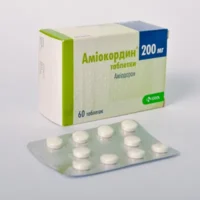Description
Enalozid (Enalapril, Hydrochlorothiazide) Tablets 12.5 mg. №20
Composition
Active ingredients: Enalapril 10 mg, Hydrochlorothiazide 2.5 mg.
Mechanism of Action
Enalozid tablets exhibit a dual mechanism of action. Enalapril, an ACE inhibitor, hinders the conversion of angiotensin I to angiotensin II, inducing vasodilation and reducing blood pressure. Hydrochlorothiazide, a thiazide diuretic, fosters diuresis, leading to decreased blood volume and subsequently lowering blood pressure.
Pharmacological Properties
Enalozid tablets synergize the antihypertensive effects of enalapril and hydrochlorothiazide. Enalapril mitigates blood pressure by obstructing the renin-angiotensin-aldosterone system, while hydrochlorothiazide augments diuresis and reduces plasma volume.
Indications for Use
Enalozid is indicated for: Managing hypertension in patients necessitating combination therapy for optimal blood pressure regulation.
Contraindications
Avoid Enalozid if:
- You are hypersensitive to enalapril, hydrochlorothiazide, or any other components of the product.
- You have a history of angioedema linked to ACE inhibitor therapy.
- You are pregnant or planning conception.
Side Effects
Common side effects of Enalozid may encompass dizziness, dry cough, and electrolyte imbalances. In the event of severe adverse reactions like profound hypotension or renal impairment, urgent medical attention is imperative.
Usage Instructions
Dosage: Ingest 1 tablet of Enalozid daily as prescribed by a healthcare provider. Swallow the tablet whole with a glass of water, with or without food.
Benefits Compared to Analogues
Enalozid tablets present enhanced blood pressure management compared to monotherapy due to the synergistic effects of enalapril and hydrochlorothiazide. Clinical studies have validated the heightened efficacy in hypertension control with this combination therapy.
Suitable Patient Groups
Enalozid is appropriate for adult patients necessitating dual therapy for hypertension control. Adjustments in dosage may be requisite for specific patient cohorts such as the elderly or individuals with renal impairment.
Storage and Shelf Life
Keep Enalozid in a cool, dry place shielded from direct sunlight. Preserve the tablets in the original packaging to safeguard against moisture. Verify the expiration date on the packaging and refrain from using the product beyond the stipulated shelf life.
Packaging Description
Enalozid tablets are encased in blister packs containing 20 tablets each. The packaging is structured to uphold the stability and integrity of the product.





